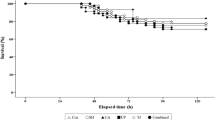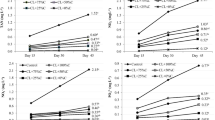Abstract
Optimal stocking densities were investigated for the sea cucumber Apostichopus japonicus Selenka under feed-supplement and non-feed-supplement regimes in net enclosures for 333 d. Substantial weight loss occurred during the aestivation phase (AE). Decreased growth rates were also observed during the winter phase (WT). In contrast, sea cucumbers showed rapid growth during the spring (SP) and autumn (AU) phases. Feeding regimes considerably influenced the growth performance, i.e., sea cucumbers grew faster under feed-supplement regime than under non-feed-supplement regime (P < 0.05). The average survival rates of sea cucumbers under feed-supplement regime were higher than those under non-feed-supplement regime for both the autumn phase and spring phase, but the differences were only significant for the latter phase (P < 0.05). The fitted B-N curves showed that the optimal stocking densities, in terms of net production, were 22.3 ind. m-2 for feed-supplement regime and 14.1 ind. m-2 for non-feed-supplement regime.
Similar content being viewed by others
References
Battaglene, S. C., Seymour, J. E., and Ramofafia, C., 1999. Survival and growth of cultured juvenile sea cucumbers, Holothuria scabra. Aquaculture, 178: 293–322.
Chang, Y., Yu, C., and Song, X., 2004. Pond culture of sea cucumbers, Apostichopus japonicus, in Dalian. In: Advances in Sea Cucumber Aquaculture and Management. Conand, C., et al., eds., FAO Fisheries Technical Paper, FAO, Rome, 269.
Chen, J. X., 1990. Brief Introduction to Mariculture of Five Selected Species in China. National Inland Fisheries Institute, Kasetsart University Campus, Bankok, Thailand, 39pp.
Chen, J., 2003. Overview of sea cucumber farming and sea ranching practices in China. Beche-de-mer Inf. 18 Bull., 18: 18–23.
Chen, J., 2004. Present status and prospects of sea cucumber industry in China. FAO Fisheries Technical Paper. Rome, 25–38.
Chen, Y., Gao, F., Liu, G-S., Shao, L-F., and Shi, G-F., 2007. The effects of temperature, salinity and light cycle on the growth and behavior of Apostichopus japonicus. J. Fish. Chin., 31(5): 687–92 (in Chinese with English abstract).
Conand, C., and Byrne, M., 1993. A review of recent developments in the world sea cucumber fisheries. Mar. Fish. Rev., 55(4): 1–13.
FAO, 2008. Aquaculture Production 1950–2006. Available from: http://www.fao.org/fishery/statistics/software/fishstat/en.
Fréchette, M., 2005. A comment on the methodology of stocking experiments. Aquaculture, 250(1–2): 291–299.
Fréchette, M., Alunno-Bruscia, M., Dumais, J-Fo., Sirois, Re., and Daigle, Gt., 2005. Incompleteness and statistical uncertainty in competition/stocking experiments. Aquaclture, 246: 209–225.
Fréchette, M., and Bacher, C., 1998. A modelling study of optimal stocking density of mussel populations kept in experimental tanks. J. Exp. Mar. Biol. Ecol., 219: 241–255.
Fréchette, M., Bergeron, P., and Gagnon, P., 1996. On the use of self-thinning relationships in stocking experiments. Aquaculture, 145(1–4): 91–112.
Fréchette, M., Gaudet, M., and Vigneau, S., 2000. Estimating optimal population density for intermediate culture of scallops in spat collector bags. Aquaculture, 183(1–2): 105–124.
Ji, T. T., Dong, Y. W., and Dong, S. L, 2008. Growth and physiological responses in the sea cucumber, Apostichopus japonicas Selenka: Aestivation and temperature. Aquaculture, 283: 180–187.
Jia, J. S., and Chen, J. X., 2001. Sea farming and sea ranching in China. FAO Fisheries Technical Paper No. 418. Rome, 43–46.
Li, X., Dong, S., Lei, Y., and Li, Y., 2007. The effect of stocking density of Chinese mitten crab Eriocheir sinensis on rice and crab seed yields in rice—crab culture systems. Aquaclture, 273(4): 487–93.
Liu, X., Gu, B., and Zhang, X., 2002. Analyses and counter measures on common problems occurring in hatcheries of sea cucumber. Mod. Fish. Mes., 26–27 (in Chinese with English abstract).
Liu, Y., Li, F., Song, B., Sun, H., Zhang, X., and Gu, B., 1996. Study on aestivating habit of sea cucumber Apostichopus Japonicus selenka I. Ecological characteristic of aestivation. J. Fish. Sci. Chin., 3(2): 41–49 (in Chinese with English abstract).
Pomerleau, S., and Engle, C. R., 2003. Production of stockersize channel catfish: effect of stocking density on production characteristics, costs, and economic risk. North Am. J. Aquac., 65: 112–119.
Purcell, S. W., and Kirby, D. S., 2006. Restocking the sea cucumber Holothuria scabra: Sizing no-take zones through individual-based movement modelling. Fish. Res., 80: 53–61.
Rahmana, M. A., Mazida, M. A., Rahmanb, M. R., Khana, M. N., Hossaina, M. A., and Hussaina, M. G., 2005. Effect of stocking density on survival and growth of critically endangered mahseer, Tor putitora (Hamilton) in nursery ponds. Aquaculture, 249: 275–84.
Ramofafia, C., Foyle, T. P., and Bell, J. D., 1997. Growth of juvenile Actinopyga mauritiana (Holothuroidea) in captivity. Aquaculture, 152: 119–128.
Rowlanda, S. J., Mifsuda, C., Nixona, M., and Boydb, P., 2006. Effects of stocking density on the performance of the Australian freshwater silver perch (Bidyanus bidyanus) in cages. Aquaculture, 253: 301–308.
Sewell, M. A., 1987. The reproductive biology of Stichopus mollis (Hutton). MSc Thesis. University of Auckland, Auckland.
Slater, M. J., and Carton, A. G., 2007. Survivorship and growth of the sea cucumber Australostichopus (Stichopus) mollis (Hutton 1872) in polyculture trials with green-lipped mussel farms. Aquaculture, 272(1–4): 389–98.
Sloan, N. A., and von Bodungen., B., 1980. Distribution and feeding of the sea cucumber Isostichopus badionotus in relation to shelter and sediment criteria of the bermuda platform. Mar. Ecol. Prog. Ser., 2: 257–264.
Sui, X., 1990. Hatching, Rearing and Propagation Technology of Sea Cucumber (Apostichopus japonicus, Selenka). China Agricultural Press, Beijing, 288pp (in Chinese).
Westoby, M., 1984. The self-thinning rule. Adv. Ecol. Res., 14: 167–225.
Xiao, P., Tan, F., Tang, Y., Yu, L., Zhang, X., and Zou, H., 2004. Salinity effect on survivalship of sea cucumber Apostichopus Japonicus (Selenka). Shandong Fish., 21(6): 20–21 (in Chinese with English abstract).
Yang, H., Li, D., and Dong, S., 1998. Preliminary studies on Piktcyktyre of filtrer-feeding fish with mollusc in fertilized seawater ponds. J. Ocean Univ. Qingdao, 28(2): 217–22 (in Chinese with English abstract).
Yang, H., Zhou, Y., Zhang, T., Yuan, X., Li, X., Liu, Y., et al., 2006. Metabolic characteristics of sea cucumber Apostichopus japonicus (Selenka) during aestivation. J. Exp. Mar. Biol. Ecol., 330: 505–510.
Yi, Y., and Lin, C. K., 2001. Effects of biomass of caged Nile tilapia (Oreochromis niloticus) /and aeration on the growth and yields in an integrated cage-cum-pond system. Aquaculture, 195: 253–267.
Yingst, J. Y., 1976. Ecological and physiological studies on the holothurians in coral reef of Palao Islands. Palao Trop. Biol. Stud., 4: 603–636.
Yu, D, and Song, B, 1999. Variation of survival rates and growth characteristics of pond cultural juvenile Apostichopus japnicus. J. Fish. Sci. Chin., 6(3): 109–110 (in Chinese with English abstract).
Yu, M., and Chang, Y., 2008. The effects of low temperature on some physiological phenomena in different population of sea cucumber Apostichoopus japonicus juveniles. J. Dalian Fish. Univ. 23(1): 31–36 (in Chinese with English abstract).
Yuan, X., Yang, H., Mao, Y., Zhang, T., and Liu, Y., 2006. Salinity effect on respiration and excretion of sea cucumber Apostichopus Japonicus (selenka). Oceanol. Limnol. Sin., 37(4): 349–356 (in Chinese with English abstract).
Author information
Authors and Affiliations
Corresponding author
Rights and permissions
About this article
Cite this article
Qin, C., Dong, S., Tan, F. et al. Optimization of stocking density for the sea cucumber, Apostichopus japonicus Selenka, under feed-supplement and non-feed-supplement regimes in pond culture. J. Ocean Univ. China 8, 296–302 (2009). https://doi.org/10.1007/s11802-009-0296-1
Received:
Revised:
Accepted:
Published:
Issue Date:
DOI: https://doi.org/10.1007/s11802-009-0296-1




